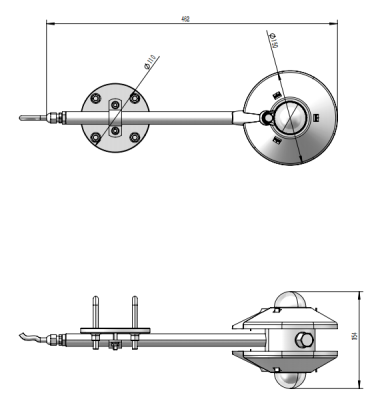| Availability: | |
|---|---|
◀◀ Key Selling Points ▶▶
Dual-Sensor Design for Accurate, Reliable Data
Customer's Question: "Is it accurate to use two separate sensors or calculate this manually?"
Our Solution: Two perfectly matched pyranometers in one instrument measure incoming and reflected radiation simultaneously. This integrated design eliminates errors from timing or environmental changes, guaranteeing instant and highly accurate albedo values.
Cost-Effective for Research and Monitoring
Customer's Question: "Is professional-grade instrumentation going to break my budget?"
Our Solution: We deliver scientific data quality at a highly competitive price point. This makes it the ideal choice for university research projects, environmental networks, and agrometeorological stations for large-scale, long-term deployment.
Rugged, Maintenance-Free, and Easy to Deploy
Customer's Question: "Is it difficult to install and maintain? How do I power it in a remote field?"
Our Solution: The sensor is passive and requires no power supply, making it truly plug-and-play. Its compact, lightweight design allows for quick and easy installation by a single person, perfect for long-term, unattended monitoring in harsh field environments.
Versatile Instrument, Multiple Data Outputs
Customer's Question: "Will I need another device to measure global solar radiation?"
Our Solution: One instrument, multiple data streams. The upward-facing sensor acts as a standard pyranometer for global solar radiation, while the downward-facing sensor measures reflected radiation. It's a single investment that delivers a rich return of data.
◀◀ Product Parameters ▶▶
Parameter | Value |
|---|---|
| Model | BGT-FZL |
Sensitivity | 7 ~ 14 μV/W·m⁻⊃2; |
Response Time | ≤ 1 min (99% response) |
Spectral Range | 0.28 ~ 50 μm |
Tolerance (Dual-Sensor Matching) | ≤ ±10% |
Internal Resistance | 150 Ω |
Weight | 1.0 kg |

Installation instructions:
1.The main body of the net radiation meter and the installation plate of the net radiation meter are assembled together by means of a hose clamp and m6 bolt group (pay attention to the installation direction);
2.Install the equipment on the mounting arm with U-bolts and a net radiation meter mounting plate. After adjusting the position, tighten the bolts.
◀◀ Application Scenarios ▶▶
Agriculture & Ecosystem Research:
Solves the question: "How much water is my field losing to evaporation? Are my crops stressed?"
Use Case: Precisely calculate evapotranspiration (ET) to optimize irrigation schedules, prevent crop drought, conserve water, and monitor overall crop health.
Meteorology, Climate & Environmental Science:
Solves the question: "How do different surfaces contribute to urban heat islands? How does land cover affect local climate?"
Use Case: Study urban heat balance (e.g., comparing asphalt, grass, and building materials), monitor snow/ice melt, and support climate modeling and surface energy balance research.
Renewable Energy Sector:
Solves the question: "How does ground reflectivity impact my solar farm's output? How much efficiency am I losing to dust or snow cover?"
Use Case: Site assessment for solar power plants (albedo affects yield), analyzing the impact of soiling (dust, snow) on PV panel performance, and optimizing solar thermal system efficiency.
Building Efficiency & Sustainable Design:
Solves the question: "Which roofing or facade material is more energy-efficient for cooling?"
Use Case: Measure the Solar Reflectance Index (SRI) of building materials (e.g., cool roofs, reflective paints) to provide data for green building design, reduce cooling costs, and mitigate urban heat.